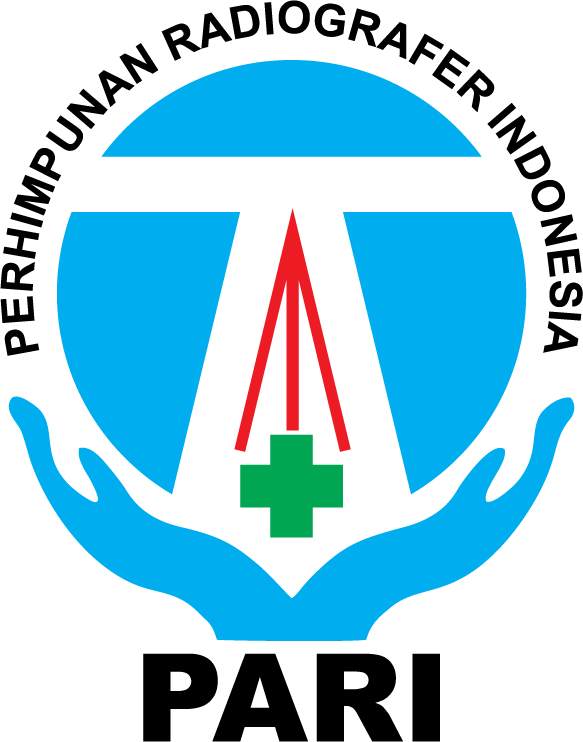PERBEDAAN PENERAPAN ACCELERATION FACTOR TERHADAP KARAKTERISTIK CITRA DIAGNOSTIK T2WI FSE PADA MRI LUMBAL KASUSHERNIATED NUCLEUS PULPOSUS (HNP)
Abstract
Background: Patients with HNP cases have a bigger chance to do a movement during MRI examination, and it causes poor MRI image. Quick time of MRI examination is needed to produce an optimal image. The technique of parallel imaging is a technique that can increase the speed of MRI data acquisition by passing through several lines of phase encoding in k-space. The GRAPPA technique is one of the methods used to reconstruct data on MRI parallel imaging techniques with better overall image quality. The technique of parallel imaging has a special parameter called acceleration factor. Acceleration factor (R-factor) will affect scan time. The purpose of this research is to know the difference of diagnostic image characteristic which is resulted in applying acceleration factor 2, 3 and 4 in parallel imaging of GRAPPA method and know the optimal acceleration factor to obtain MRI image of lumbar HNP case.
Methods: This research type is quantitative research with descriptive approach. The study was conducted by MRI Siemens 3 T in RSUD Dr. Soedono Madiun. The data were 30 MRI images of lumbar sagittal of HNP cases on T2WI FSE with acceleration factor 2, 3 and 4 GRAPPA methods
Result: The results of this study indicate that there are differences in diagnostic image characteristics in the application of acceleration factor 2 and 4, 3 and 4 with VGA test. Acceleration factor value optimal with VGC test known is acceleration factor 2 and 3
Conclusion: Based on the result there were differencediagnostic image characteristics of MRI Lumbar in sagital plane Fast Spin Echo (FSE)sequence with variation acceleration factor 2, 3 and 4 parallel imaging GRAPPA methode in case Herniated Nucleus Pulposus (HN0). The optimal value of variation acceleration factor value for MRI Lumbar examination of Heniated Nucleus Pulposus (HNP) is 2 dan 3.Keywords
Full Text:
PDFReferences
Baert, Knauth, & Sartor. (2007). Parallel Imaging In Clinical MR Applications. Munich, Germany: Grosshadern Ludwig Maximilian University of Munich.
Båth, M., &Månsson, L. G. (2007). Visual grading characteristics (VGC) analysis: A non-parametric rank-invariant statistical method for image quality evaluation. British Journal of Radiology, 80(951)
Blaimer, & Al, M. Te. (2004a). SMASH, PILS, GRAPPA: How to Choose The Optimal Methode. Top MagnReson Imaging, Volume 15, Number 4.
Blaimer, & Al, M. Te. (2004b). SMASH, SENSE, PILS, GRAPPA : How to Choose The Optimal Methode, Volume 15, Number 4.
Blaimer, M., Breuer, F. A., Seiberlich, N., Mueller, M. F., Heidemann, R. M., Jellus, V., … Jakob, P. M. (2006). Accelerated volumetric MRI with a SENSE/GRAPPA combination. Journal of Magnetic Resonance Imaging, 24(2), 444–450.
Brown, M. A., &C.Samelka, R. (2015). MRI Basic Principle and Applications. (J. W. and S. Inc, Ed.). New Jersy.
Bushong. (2015a). Magnetic Resoance Imaging : Physical and Biological Principle (Fourth Edi). Texas, USA: The University of Texas Health Science Center at San Antonio San Antonio, Texas.
Bushong. (2015b). MAGNETIC RESONANCE IMAGING : PHYSICAL AND BIOLOGICAL PRICIPLE (Fourth Edi). USA: The University of Texas Health Science Center at San Antonio San Antonio, Texas.
Busong, S. (2003). Magnetic Resonansce Imaging, Physical and Biological Principle (Seconf Edi). Mosby: : Washington DC.
Catherine, W. (2014). Westbrook - Handbook OfMri Technique.pdf. Blackwell Science Ltd.: United Kingdom.
D’Antoni, A. V. (2016). Gray’s Anatomy. The Anatomical basis of clinical practice. Clinical Anatomy.
Dale, M.Brian, M.A, B., Richard, C., &Sememlka. (2015). MRI Basic Principle and Applications (Fifth Edit). : New Jersey: John Wiley and Sons Inc.
Fast, A., &Goldsher, D. (2007). Navigating the Adult Spine: Bridging Clinical Practice and Neuroradiology.
Fruehwald-Pallamar, J., Szomolanyi, dkk (2012). Parallel imaging of the cervical spine at 3T: Optimized trade-off between speed and image quality. American Journal of Neuroradiology, 33(10), 1867–1874.
Griswold, M. A., Jakob, P. M., Heidemann, R. M., Nittka, M., Jellus, V., Wang, J., … Haase, A. (2002). Generalized Autocalibrating Partially Parallel Acquisitions (GRAPPA). Magnetic Resonance in Medicine, 47(6), 1202–1210.
Hidayat, A. A. . (2011). MetodePenelitianKebinanan&TeknikAnalisis Data. Jakarta: SalembaMedika.
Larkman, D., & Nunes, R. (2007). Parallel Magnetic Resonance Imaging. London: The Imaging Sciences Department, Clinical Science Cetre, Fakculty of Medicine,Imperial College.
Ludewig, E., Richter, A., & Frame, M. (2010). Diagnostic imaging - Evaluating image quality using visual grading characteristic (VGC) analysis. Veterinary Research Communications, 34(5), 473–479.
Matt A. Bernstein, K. F. K. (n.d.). HandBookOf MRI Pulse Sequences. United Kingdom: University of Illionis of any medical equipment manufacture.
Moeller. (2013). MRI Parameters and Positioning. Orbit An International Journal On Orbital Disorders And Facial Reconstructive Surgery (Vol. 512).
Moeller, T. B., &Reif, E. (2000). Normal Findings in CT and MRI.
Moore, K., Dalley, A., Agur, A., & More, M. (2013). Anatomiberorientasiklinis (Edisike 5). Jakarta: Erlangga.
Muttaqin, A. (2008). AsuhanKeperawatanKliendenganGangguanSistemPersarafan, Jakarta(: SalembaMedika).
Nael, K., Saleh, R., Lee, M., dkk (2006). High-spatial-resolution contrast-enhanced MR angiography of abdominal arteries with parallel acquisition at 3.0 T: Initial experience in 32 patients. American Journal of Roentgenology, 187(1), 235.
Noor, H., &Zairin. (2012). Buku Ajar GangguanMuskuloskeletal (Jilid 1). Jakarta: SalembaMedica.
Notoatmodjo, S. (2002). MetodologiPenelitianKesehatan. Jakarta: RinekaCipta.
Notosiswoyo, M., &Suswati, S. (2004). Pemanfaatan Magnetic Resonance Imaging (Mri) SebagaiSaranaDiagnosaPasien. Media Penelitian Dan PengembanganKesehatan, XIV, 8–13.
Pearce, E. (2006). AnatomidanFisiologiuntukParamedis. Jakarta: GramediaPustakaUtama.
Preibisch, C., Wallenhorst, T., Heidemann, dkk(2008). Comparison of parallel acquisition techniques generalized autocalibrating partially parallel acquisitions (GRAPPA) and modified sensitivity encoding (mSENSE) in functional MRI (fMRI) at 3T. Journal of Magnetic Resonance Imaging, 27(3), 590–598.
Rejo, A. (2006). MRI of herniated nucleus pulposus. Correlation with clinical findings, determinants of spontaneous resorption and effects of anti-inflammatory treatments on spontaneous resorption. UniversitatisOuluensis.
Runge, R, W., &Trelles, M. (2014). The Physics of Clinical MR Taught Through Images (Third Edit). New York: Thieme Medical Publisher.
Schneider, & Matthias. (2008). GPGPU for Accelerated GRAPPA Auto Calibration in Magnetic Resonance Imaging.
Siemens. (2004). iPATMagnetomAvantoMagnetomEspree. Germany.
Sugiyono. (2007). MetodePenelitianPendidikanPendekatanKuantitatif, kualitatif, dan R&D. Bandung: Alfabeta.
Wang, & Al, H. e. (2010). Cross-Sampled GRAPPA for Parallel MRI. USA: University of Wisconsin.
Weishaupt, D.Kochil, &Maricek. (2006). How Does MRI Work? An Introduction The Physics and Fuction of Magnetic Resonance Imaging (Second Edi). Spinger.
Westbrook, C., Roth, C. K., & Talbot, J. (2011). MRI IN PRACTICE.
Westbrook, Chaterine, &Kaut, C. (2011). MRI in Practice, Fouth Edition. United Kingdom: Blackwell Science Ltd.
DOI: https://doi.org/10.31983/jimed.v5i2.4464
Article Metrics
Refbacks
- There are currently no refbacks.
JURNAL IMEJING DIAGNOSTIK by http://ejournal.poltekkes-smg.ac.id/ojs/index.php/jimed is licensed under a Creative Commons Attribution-ShareAlike 4.0 International License.

.png)
.png)
.png)
.png)
.png)
.png)
.png)











